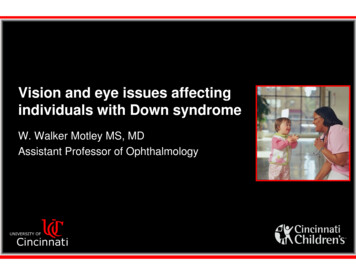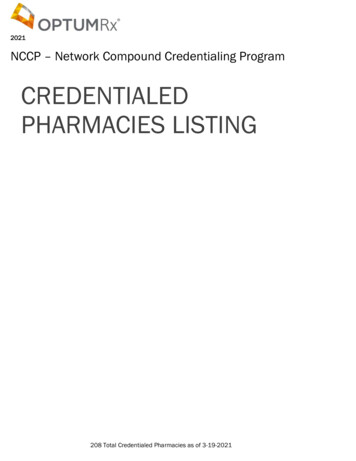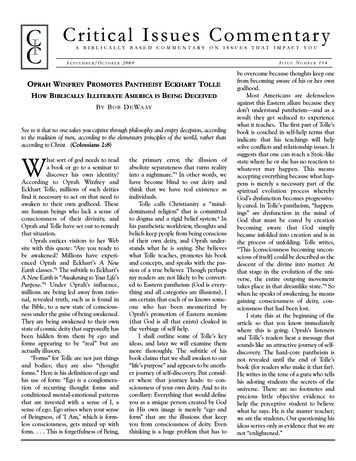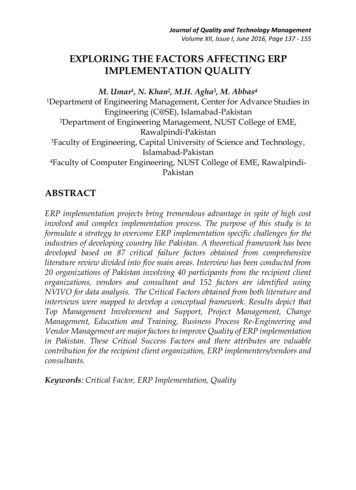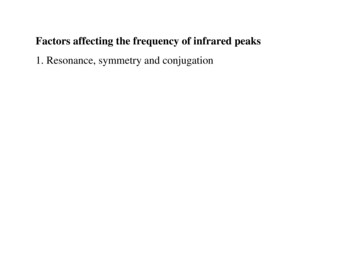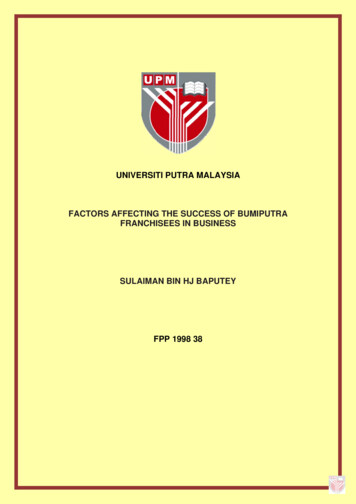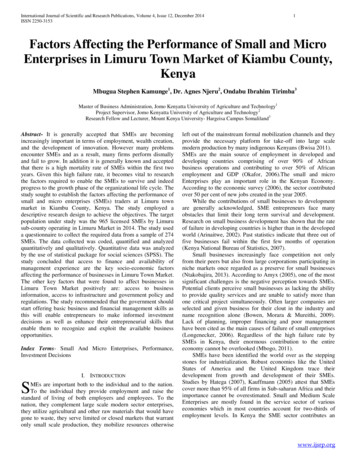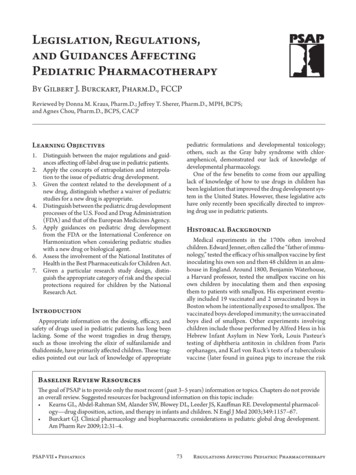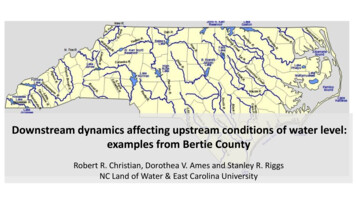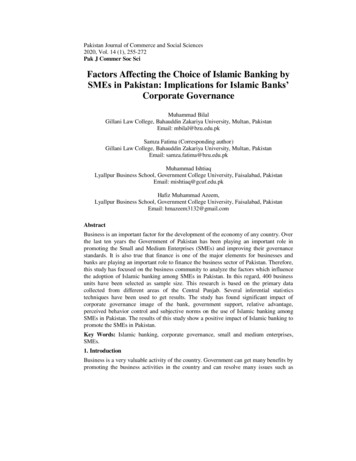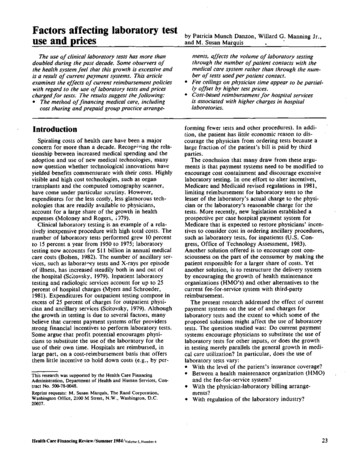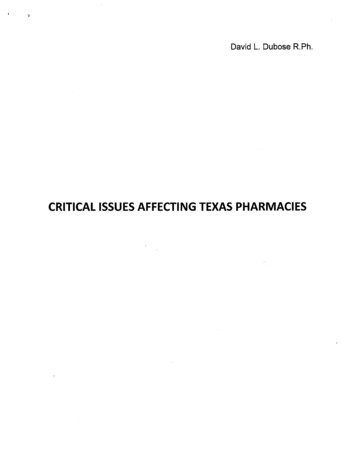
Transcription
'David L. Dubose R.Ph.CRITICAL ISSUES AFFECTING TEXAS PHARMACIES
Critical Issues Affecting Texas PharmaciesExecutive SummaryTexas will have a potential shortage of over 18,000 employees in thesupport role as pharmacy technicians or technicians in training in the year2020. Pharmacy technicians perform technical tasks that do not requireprofessional judgement of the pharmacist. Texas began regulatingpharmacy technicians due to concerns about theft and loss of drugs. Allapplicants seeking a pharmacy technician license must have a high schooldiploma or equivalency and pass a board-approved national certifyingexam. Today there are two exams, the Pharmacy Technician CertificationExam (PTCE) and the Exam for Certification of Pharmacy Technicians(ExCPT) which are ACCREDITED by the NCCA (National Commission forCertifying Agencies). Texas has limited their selection to one exam, thePTCE.In the year 2020, the PTCB will change their requirements to sit for thePTCE exam. The future Pharmacy Technician will have to attend an ASHPaccredited school. There are currently 28 accredited colleges or vocationalschools located in 15 counties leaving 239 counties with no way to traintechnicians. Some of these counties include: Walker, Robertson, Polk,Liberty, Webb and Williamson. There will be no home study or employeebased training and high schools will no longer be able to offer pharmacytechnician training programs in all 254 counties.Two exams would give the options:1. Go to college and take the Pharmacy Technician Certification Exam(PTCE)2. Home, school, or employee based training (draw from theircommunities) and take the (Exam for Certification of PharmacyTechnicians) ExCPTWhy put in place barriers when the employer has the ability to set its ownhiring requirements, and thus if a college degree is desirable, the employercan set that requirement?Note:The PTCB has paid over 2.5 million in royalties to the National Associationof Boards of Pharmacy from the years 2011 to 2014.
Critical Issues Affecting Texas Pharmacies1. Pharmacy technicians and technician trainees:a. Technicians perform technical tasks that do not require professionaljudgement, such as counting and labeling medications, and must work underthe supervision of a pharmacist.b. Texas began regulating pharmacy technicians more recently in 2004, due toconcerns about theft and loss of drugs.c. All applicants seeking a pharmacy technician license must have a high schooldiploma or equivalency and pass a board-approved national certifying exam.d. Prospective pharmacy technicians may choose to first apply for techniciantrainee status, which allows the trainee to gain experience for up to two yearsbefore taking and passing the certifying exam.e. In fiscal year 2015, the board registered 41,990 pharmacy technicians and18,777 technician trainees.2. Pharmacy Technician Certification Board (PTCB) requirements for 2020:a. All schools teaching must have American Society of Health SystemPharmacists (ASHP) accreditationb. Requiring future technicians to attend a college or vocational tech schoolc. Cost ranging from 3,645 to 23,220 - plus room and boardd. 28 accredited colleges/vocational technical schoolse. Length of 1 to 2 yearsf. No home study or employee based training3. Facts:2014 - Texas has registered with the Texas State Board of Pharmacy (TSBP):Pharmacy Technicians41,700Pharmacy Technician trainees 15,75157,451 total number of licenses2015 - Texas has registered with the Texas State Board of Pharmacy (TSBP):Pharmacy Technicians41,990Pharmacy Technician trainees 18.77760,767 total number of licenses1
a. Texas keeps about 60,000 Certified Pharmacy Technicians (CPhTs) andtechnicians in trainingb. Texas has a 25% turnover rate each yearc. Texas will need 15,000 technicians or technicians in training each year tomeet demandsd. 28 colleges and vocational schools in Texas, each with a class potential of 20to 30e. If colleges and vocational schools have a class of 30, we will need 500schools in Texasf. Year 2021: the 28 Colleges and Vocational schools would graduate 840students, a shortfall of 14, 160 Certified Pharmacy Technicians (CPhTs)g. Year 2022: another 14, 160 short; at that rate, a 50% shortage of CertifiedPharmacy Technicians (CPhTs) in 2 yearsh. Shortfall does not include Bureau of Labor Statistics of a 20o/o growth by 2022.4. Concerns facing Texas Pharmacies:a. Demand and competition for technicians will be exorbitantb. Texas has 254 counties with the 28 schools located in 15 counties. (Seeattached map)1. Pharmacies in smaller counties have a problem recruiting Pharmacists,how will they recruit technicians?2. Harris County has 9 schools, Dallas and Tarrant have total of 5c. Chain stores with American Society of Health System Pharmacists (ASHP)programs will become training grounds for all.5. Solution: Texas State Board of Pharmacy should recognize both the Examfor Certification of Pharmacy Technicians {ExCPT) given by NHA {NationalHealthcareer Association) and the Pharmacy Technician Certification Exam(PTCE) given by the PTCB (Pharmacy Technician Certification Board)a. Both Pharmacy Technician Certification Exam (PTCE) and Exam forCertification of Pharmacy Technicians (ExCPT) are ACCREDITED by theNCCA (National Commission for Certifying Agencies)2
b. Passing of either test earns you the designation of a nationally CertifiedPharmacy Technician. (CPhT)c. Home or employee based training allows local pharmacies to draw from theircommunities6. Texas State Board of Pharmacy had the exams evaluated by aevaluator:Evaluator #1NHA (ExCPT)Score 576PTCB (PTCE)Score 592Evaluator #2NHA (ExCPT)PTCB (PTCE)3rdpartyScore 530Score 5547. An interesting fact:a. Pharmacy Technician Certification Board (PTCB) exam pays royalties to:1. ASHP (American Society of Health-System Pharmacists)2. APhA (American Pharmaceutical Association)3. NABP (National Association of Boards of Pharmacy)4. ICHP (Illinois Council of Health-System Pharmacists)5. MPA (Michigan Pharmacist Association)Each received 2.5 million from 2011 to 2014b. The ExCPT (Exam for Certification of Pharmacy Technicians) exam paysroyalties to:1. NCPA (National Community Pharmacists Association)2. NACDS (National Association of Chain Drug Stores).Two exams would give the options:1. Go to college and take the Pharmacy Technician Certification Exam (PTCE)2. Home or employee based training (draw from their communities)and take the (Exam for Certification of Pharmacy Technicians) ExCPTEnd result is a Certified Pharmacy Technician (CPhT).3
Notes The Texas State Board Pharmacy does not require a Certified Technician torenew their certification once they register with the Board. Texas is the only state that selects its approved certifying organization through aRequest for Qualifications (RFQ) process. They have used this process twice, most recently in 2014. Every four years, the Board posts a Request for Qualifications (RFQ) to solicit acertification "vendor." The document lists the minimum qualifications of thevendor, as well as a long list of documentation that interested parties mustprovide. Several psychometricians appointed by the Board then review the applicationmaterials and rate the quality of the responses on a numeric scale. The Board then reviews the scores and commentary, and they make adetermination about which organization should win the bid. While there is no language in Texas statutes, regulations, or the Request forQualifications (RFQ) to limit the Boa.rd to selecting just one vendor, they havehistorically limited their selection to just one vendor. Accordingly, they have selected Pharmacy Technician Certification Board(PTCB) exclusively. It should be noted that the scores of both organizations havebeen very close both times, with Pharmacy Technician Certification Board(PTCB) slightly ahead. In the recent 2014 Request for Qualifications (RFQ), thedifference in scores was only 3.5%. An objective third party could argue that the scores were so close that the Boardcould justify selecting two vendors. However, that is not the path they chose.Summary1. Can enough Texans be attracted to pharmacy technician work to meet thedemand if the proposed PTCB educational requirements are put in place in2020? Cost of educational programs. Declining inquiries and completion rates already happening.4
2. With limited pharmacy technician educational opportunities outside of the 15counties with ASHP accredited programs, will trained pharmacy technicians beattracted to seek employment in the other 239 counties? Employer based Training allows local pharmacies to draw from theircommunities. Higher educational requirements will require attracting pharmacy techniciansfrom counties with schools to counties without schools.3. Can the Board demonstrate that the heightened barriers to entry - Associate'sDegree coupled with ASHP-accredited pharmacy technician training - willaddress the stated concern of diversion (theft) of medications? Is there any evidence that demonstrates that in-house trained pharmacytechnicians cause greater diversion than those with school-based training?Associate's Degrees? ASHP-accredited training?4. How does a general Associate's Degree relate to the tasks to be performed by anentry level pharmacy technician? Said differently, why put in place barriers when the employer has the ability toset its own hiring requirements, and thus if a college degree is desirable, theemployer can set that requirement?5. In states where pharmacy technician certification is required to practice, 16 out of21 recognize both the ExCPT and the PTCE.6. Effective January 1, 2020, over 18,000 pharmacy technician trainees will beunemployed. This creates a workforce issue for all pharmacies.Thank you,David L. Dubose R.Ph.5
Issue 2Key Elements of the Texas State Board of Pharmacy’s Statute Do Not Conform toCommon Licensing Standards.Pharmacy technicians and technician trainees. Pharmacy technicians performtechnical tasks that do not require professional judgment, such as counting andlabeling medications, and must work under the supervision of a pharmacist. Texasbegan regulating pharmacy technicians more recently, in 2004, due to concernsabout theft and loss of drugs. All applicants seeking a pharmacy technician licensemust have a high school diploma or equivalency and pass a board-approvednational certifying exam. Prospective pharmacy technicians may choose to firstapply for technician trainee status, which allows the trainee to gain experience forup to two years before taking and passing the certifying exam. In fiscal year 2015,the board registered 41,990 pharmacy technicians and 18,777 technician trainees.Critical Issues Affecting Texas Pharmacies1. Pharmacy Technician Certification Board (PTCB) requirements for 2020:a. All schools teaching must have American Society of Health SystemPharmacists (ASHP) accreditationb. Requiring future technicians to attend a college or vocational tech schoolc. Cost ranging from 3,645 to 23,220 – plus room and boardd. 28 accredited colleges/vocational technical schoolse. Length of 1 to 2 yearsf. No home study or employee based training2. Facts:2014 Texas has registered with the Texas State Board of Pharmacy (TSBP):Pharmacy Technicians41,700Pharmacy Technician trainees 15,75157,451 total number of licenses2015 Texas has registered with the Texas State Board of Pharmacy (TSBP):Pharmacy Technicians41,990Pharmacy Technician trainees 18,77760,767 total number of licensesa. Texas keeps about 60,000 Certified Pharmacy Technicians (CPhTs) andtechnicians in training
b. Texas has a 25% turnover rate each yearc. Texas will need 15,000 technicians or technicians in training each year tomeet demandsd. 28 colleges and vocational schools in Texas, each with a class potential of 20to 30e. If colleges and vocational schools have a class of 30, we will need 500schools in Texasf. Year 2021: the 28 Colleges and Vocational schools would graduate 840students, a shortfall of 14,160 Certified Pharmacy Technicians (CPhTs)g. Year 2022: another 14,160 short; at that rate, a 50% shortage of CertifiedPharmacy Technicians (CPhTs) in 2 yearsh. Short fall does not include Bureau of Labor Statistics of a 20% growth by2022.3. Concerns facing Texas Pharmacies:a. Demand and competition for technicians will be exorbitantb. Texas has 254 counties with the 28 schools located in 15 counties.(Seeattached map)1. Pharmacies in smaller counties have a problem recruiting Pharmacists,how will they recruit technicians?2. Harris County has 9 schools, Dallas and Tarrant have total of 5c. Chain stores with American Society of Health System Pharmacists (ASHP)programs will become training grounds for all.4. Solution: Texas State Board of Pharmacy should recognize both the Examfor Certification of Pharmacy Technicians (ExCPT) given by NHA (NationalHealthcareer Association) and the Pharmacy Technician CertificationExam (PTCE) given by the PTCB (Pharmacy Technician CertificationBoard)a. Both Pharmacy Technician Certification Exam (PTCE) and Exam forCertification of Pharmacy Technicians (ExCPT) are ACCREDITED by theNCCA (National Commission for Certifying Agencies)b. Passing of either test earns you the designation of a nationally CertifiedPharmacy Technician. (CPhT)c. Home or employee based training allows local pharmacies to draw fromtheir communities5. Texas State Board of Pharmacy had the exams evaluated by a 3rd partyevaluator:
Evaluator #1NHA (ExCPT)PTCB (PTCE)Score 576Score 592Evaluator #2NHA (ExCPT)PTCB (PTCE)Score 530Score 5546. An interesting fact:a. Pharmacy Technician Certification Board (PTCB) exam pays royalties to:1. ASHP (American Society of Health-System Pharmacists)2. APhA (American Pharmaceutical Association)3. NABP (National Association of Boards of Pharmacy)b. The ExCPT (Exam for Certification of Pharmacy Technicians) exam paysroyalties to:1. NCPA (National Community Pharmacists Association)2. NACDS (National Association of Chain Drug Stores).Two exams would give the options:1. Go to college and take the Pharmacy Technician Certification Exam (PTCE)2. Home or employee based training (draw from their communities)and take the (Exam for Certification of Pharmacy Technicians) ExCPTEnd result is a Certified Pharmacy Technician (CPhT).Note The Texas State Board Pharmacy does not require a Certified Technician torenew their certification once they register with the Board. Texas is the only state that selects its approved certifying organization througha Request for Qualifications (RFQ) process. They have used this process twice, most recently in 2014. Every four years, the Board posts a Request for Qualifications (RFQ) to solicit acertification “vendor.” The document lists the minimum qualifications of thevendor, as well as a long list of documentation that interested parties mustprovide. Several psychometricians appointed by the Board then review the applicationmaterials and rate the quality of the responses on a numeric scale. The Board then reviews the scores and commentary, and they make adetermination about which organization should win the bid.
While there is no language in Texas statutes, regulations, or the Request forQualifications (RFQ) to limit the Board to selecting just one vendor, they havehistorically limited their selection to just one vendor. Accordingly, they have selected Pharmacy Technician Certification Board(PTCB) exclusively. It should be noted that the scores of both organizationshave been very close both times, with Pharmacy Technician Certification Board(PTCB) slightly ahead. In the recent 2014 Request for Qualifications (RFQ), thedifference in scores was only 3.5%. An objective third party could argue that the scores were so close that the Boardcould justify selecting two vendors. However, that is not the path they chose.Summary1. Can enough Texans be attracted to pharmacy technician work to meet thedemand if the proposed PTCB educational requirements are put in place in2020? Cost of educational programs. Declining inquiries and completion rates already happening.2. With limited pharmacy technician educational opportunities outside of the 15counties with ASHP accredited programs, will trained pharmacy technicians beattracted to seek employment in the other 239 counties? Employer based Training allows local pharmacies to draw from theircommunities. Higher educational requirements will require attracting pharmacy techniciansfrom counties with schools to counties without schools.3. Can the Board demonstrate that the heightened barriers to entry – Associate’sDegree coupled with ASHP-accredited pharmacy technician training – willaddress the stated concern of diversion (theft) of medications? Is there any evidence that demonstrates that in-house trained pharmacytechnicians cause greater diversion than those with school-based training?Associate’s Degrees? ASHP-accredited training?4. How does a general Associate’s Degree relate to the tasks to be performed byan entry level pharmacy technician? Said differently, why put in place barriers when the employer has the ability toset its own hiring requirements, and thus if a college degree is desirable, theemployer can set that requirement?
5. In states where pharmacy technician certification is required to practice, 16 outof 21 recognize both the ExCPT and the PTCE.Thanks,David L. Dubose R.Ph.
5. In states where pharmacy technician certification is required to practice, 16 out of 21 recognize both the ExCPT and the PTCE. 6. Effective January 1, 2020, over 18,000 pharmacy technician trainees will be unemployed. This creates a workforce i
